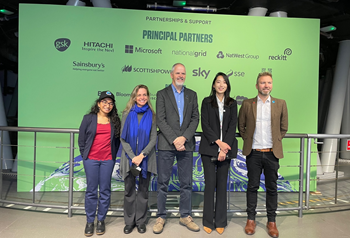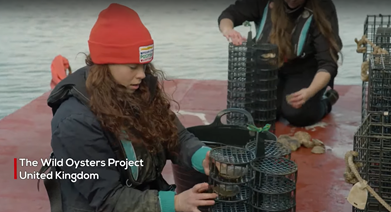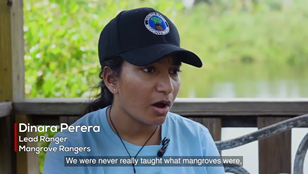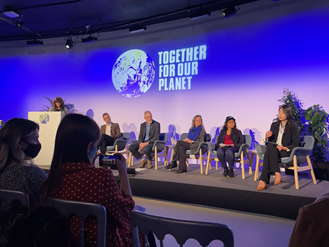During UNFCCC COP26, the ‘Coast to Coast: nature-based solutions for climate, biodiversity and people’ was cohosted by the Royal Society for the Protection of Birds (RSPB, Birdlife UK Partner) and the Environment Agency (EA) on 7th November 2021. The session moderated by Ms. Melanie Heath from BirdLife International, focused to share successful case studies on habitat restoration in coastal wetlands, and highlight the benefits to climate mitigation, adaptation and resilience, economy, health, and well-being for local communities.
The following panels were Mr. Michael Copleston from RSPB, Mr. Roger Proudfoot from EA, Ms. Catherine Childs from National Trust for Cayman, Ms. Hyeseon Do from EAAFP Secretariat, Mr. Alex Hai Zhang from Eco Foundation Global, Mr. Qijang Wu from Yancheng Wetland and Natural World Heritage Protection and Management Center, Dr. Kyong-O Moon from the World Heritage Promotion Team of Korean Tidal Flats, Ms. Dinara Perera from Mangrove Rangers, and members from Protect Our Future Leader.
 Panels for Coast-to-Coast session ©Yoo Jung Kwon
Panels for Coast-to-Coast session ©Yoo Jung Kwon
To safeguard 1.5 degrees Celsius, nature-based solution plays a vital role to secure a resilient and sustainable environment. As a cost-effective solution, with multiple benefits to the environment and people, strong focus was made to protect, restore, create and invest in nature. For instance, mangroves are used as float defensive and carbon absorbers, as they can avoid droughts, act as natural sponges to absorb extra rain, and protect local communities from hurricanes and storms. Yet, there is unavoidable loss of salt-marshes due to land development, agriculture, and rising sea levels. Hence, losing nature comes through the cost of losing habitat, and vital ecosystem services. The session highlighted the need for more nature-based projects at a larger scale, and for all stakeholders to come together to plan and adapt to nature-based solutions.
Blue carbon projects were shared during the session such as the seagrass planting program and the Wild Oysters Project in UK, beach clean ups along Korean tidal flats and the release of the ‘First Basic Plan for Management and Ecological Restoration of Tidal Flats and Adjacent Areas 2021-2025’ in Republic of Korea (ROK), Cayman Islands Mangrove Rangers etc. Cayman Islands Mangrove Rangers shared the importance of coastal wetlands as their historical, natural, and cultural heritage, which is supported through educational programs, and nature funds to protect the area.
A management framework of different stakeholders to protect and manage Yancheng Wetland in support with a three-year action plan and the expected Global Coastal Forum held in Yancheng this mid-December was shared by Mr. Qijang Wu. Other projects included the Mission Blue Hope Stops, where it nominates protected areas in ecologically significant parts of the oceans that are vital to the marine species and communities that rely on it. Such initiatives were stressed to be shared throughout COP26.
 |
 |
Blue carbon projects ©COP26 YouTube
Each panelist shared their experience putting strong emphasis on the need and capability of scientific research, with knowledge and technical sharing. Mr. Michael Copleston highlighted that for a project to work it was crucial to take a clear focus on the aim and innovation needed with intention to implement at a larger scale. As well as to be steering clear on what the project or program is aiming to achieve, and to take an open-minded approach with people, and work with local communities to ensure their needs are included.
Dr. Kyong-O Moon shared the major stakeholders of the Getbol, Korean tidal flats World Heritage steering committee composed of NGOs, experts, public officials, and local residents. As local residents are recognized as ‘the most important actor of on-site management’ the committee included 20% of local residents to ensure they were included in the policy making process and to closely monitor its implementation. Moreover, he mentioned how there has not been active discussion on habitat restoration and climate change in ROK. Yet according to the Science of The Total Environment, it highlighted the ROK total tidal area stores around 13 million tons of carbon dioxide.
Ms. Hyeseon Do used migratory waterbirds as flagships to promote international cooperation to improve coastal management, e.g. the story of Bar-tailed Godwit, and their nonstop flight from New Zealand to ROK, heading further to Alaska, and sharing of experience in controlling spread of invasive Spartina (through MOU between China and New Zealand), and also introduced EAAFP partnerships across 22 countries to address a shared issue, conservation of migratory waterbirds, many of which depend on coastal ecosystems. Since COP26, the needs of stronger cooperation in the different level of community including international, regional and local was highlighted as birds are strong indicators and sentinels of coastal ecosystem health and highlight our need to act and inspire action more together across political divides.
Ms. Dinara Perera stressed the need for a cultural political shift, as mangroves are currently seen as wastelands so are less prioritized when it comes to urbanization and development. She advised the needs for a holistic approach on individual habitats to be viewed as part of the whole ecosystem.
Mr. Alex Hai Zhang shared that strong political support and will is important, such as the global community support reflected during the 2012 IUCN resolution to increase protected areas and species of birds in West/Yellow Sea. Hence, through this commitment more than 60 international organizations wrote to the committee member of the World Heritage Committee members to support the series of the inscription of the sites in the region. Most importantly, the need for local community engagement was stressed. The members from Protect our Future Leader also highlighted the importance of collaboration, education, and legislation.
 Panel discussion during the session ©Yoo Jung Kwon
Panel discussion during the session ©Yoo Jung Kwon
The session continued with a clear focus on preventing deforestation and preservation, rather than merely restoration. Since it takes over 30 years to ensure the plant provides substantial ecosystem services. Hence as we face existential threat due to the increasing global temperature, islands may no longer exist as coastal habitats that protect the Small Island Developing States, as countries continue to lose habitat through climate change. Hence building consensus through an international platform, engaging scientific work to bring successful case studies such as the Regional Flyway Initiative, and establishing platforms such as the wetlands institute were highlighted. Such as, the wetland center in UK which ensures the general public can learn and study wetlands, and also the migrating bird species.
The takeaway message was to ensure that through proper planning it builds shared vision that will take a step-to-step approach implementing the set goal. Moreover, flexibility to take on different approaches such as the carbon offset innovative finance model highlights that such initiative can be accomplished through stronger partnership and cooperation. And since scaling up projects is essential to make meaningful impact, it needs to be supported through strong strategic awareness such as clearly communicating those benefits to the local. This comes through investment, the mind set and political will. That will then secure the financial impacts on local businesses and communities, increasing local jobs as well.
Watch the event recording:
Watch the video “Coast to Coast: Restoring and Protecting Coastal Wetlands” by RSPB
Event details:
- The Coast to Coast: NbS for climate, biodiversity, people webpage




